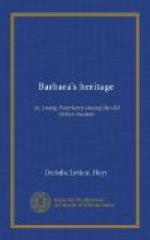“And there is one thing more that we must not forget. There may be pictures with bad motifs as well as good ones—weak and simple ones, as well as strong and holy ones—and yet they may be full of all artistic qualities of representation. What is true with regard to literature is true in respect to art. It is, after all, the message that determines the degree of nobility.
“Art was given for that.
God uses us to help each other so,
Lending our minds out.
wrote Mr. Browning, and we should always endeavor to find out whether the artist has loaned his mind or merely his fingers and his knowledge of the use of his materials. If we find thought in his picture, we should then ask to what service he has put it.
“If a poem consist only of words and rhythms, how long do you think it ought to live? And if a picture possess merely forms and colors, however beautiful they may be, it deserves no more fame. And how much worse if there be meaning, and it be base and unworthy!”
“Does he not put it well?” whispered Malcom to Bettina from his usual seat between her and Margery. “I feel as if he were pouring new thoughts into me.”
“Now, the one thing I desire to impress upon you to-night,” continued Mr. Sumner, “is that these old masters of painting who lived in the thirteenth, fourteenth, and fifteenth centuries had messages to give their fellow-men. Their great endeavor was to interpret God’s word to them,—you know that in those days and in this land there was no Bible open to the common people,—and what we must chiefly look for in their pictures is to see whether or not they told the message as well as the limitation of their art-language permitted.
“At first, no laws of perspective were known. None knew how to draw anything correctly. No color-harmonies had been thought of. These men must needs stammer when they tried to express themselves; but as much greater as thought is than the mere expression of it so much greater are many of their works, in the true sense, than the mass of pictures that make up our exhibitions of the present day.
“Then, also, it is a source of the deepest interest to one who loves this art to watch its growth in means of expression—its steady development—until, finally, we find the noblest thoughts expressed in perfect forms and coloring. This we can do here in Florence as nowhere else, for the Florentine school of painting was the first of importance in Italy.
“So,” he concluded, “do not look for beauty in these pictures which we are first to study; instead of it, you will find much ugliness. But strive to put yourselves into the place of the old artists, to feel as they felt. See what impelled them to paint. Recognize the feebleness of their means of expression. Watch for indications in history of the effect of their pictures upon the people. Strive to find originality in them, if it be there, for this quality gives a man’s work a certain positive greatness wherever we find it; and so learn to become worthy judges of that which you study. Soon, like me, you will look with pity on those who can see nothing worthy of a second glance in these treasures of the past.




